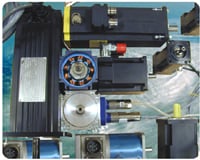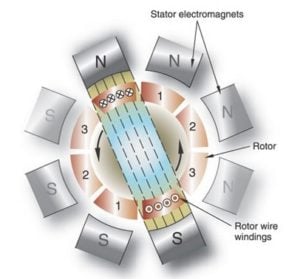Servo Motors
Over time, however, the boundaries of what is a servo motor and what isn't have become a little blurred. This ambiguity is partially due to the expanded uses of servo drives beyond servo control.
Decades ago, servo drives did little more than amplify a command signal, hence their alternate name, servo amplifiers. As motion control technology evolved, engineers discovered that servo amplifiers could be modified and set up to control other motor types the same way they control servo motors. The servo drives of today are much more versatile and can easily be configured for a wide variety of motor types, yet still keep "servo" in their title.
Servo motors are used in millions of applications from remotely operated vehicles to CNC milling machines to surgical robots. Servo motors are popular for a number of reasons, including their power efficiency and small size.
But most importantly, they can offer very precise control when they have a feedback device and a servo drive. ADVANCED Motion Controls' drives are capable of controlling just about any servo motor you can find.
Brushed DC (single phase)
The commutator is a round piece with metallic contact points connected to each of the rotor's coil loops. The conductive brushes aren't like hair brushes; they are typically pieces of a graphite mixture that are spring loaded to make electrical contact with the motor's commutator as it spins to provide the electrical current. They offer great performance at an economical price. However one drawback is the physical contact between the brushes and commutator creates friction, which wears down the brushes and creates lots of dust particles over time. Because of this, brushed motors are more susceptible to maintenance costs over a long period of time than their brushless counterparts, despite lower initial costs. For low cost applications, short life applications, or applications where the motor is easily accessible to be repaired or replaced, then a DC brushed motor can do the trick.
Servo motor control is our game, which is why every single ADVANCED Motion Controls servo drive can run a DC brushed motor, provided it is in the appropriate power range of course.
Brushless DC (three phase)
For applications where the motor may not be easily accessible for maintenance or higher efficiency than a brushed motor is desired, then a three phase brushless DC motor can be the way to go.
Brushless servo motor control is easy with our products. With few exceptions all of our actively marketed servo drives can run DC brushless motors.
Brushless AC
These days, the distinction is less about the motors themselves when comparing Brushless AC motors with Brushless DC motors, but rather how they are driven by the servo drive. With Brushless AC, the current is constantly running through the three phases, but alternating back and forth in a sinusoid fashion as you would see in the AC supply out of the wall. This phenomenon creates a net rotating magnetic field, rotating much more smoothly than the magnetic field achieved by turning on and off motor phases in a DC brushless motor.
Much like DC brushless motors, they rarely require maintenance due to the lack of mechanical brushes. The drawback to AC brushless motors when compared to DC brushless motors (and AC induction motors which will be discussed later) is their even greater initial cost. However, their performance efficiency and minimal maintenance cost can make up for it in the long run.
AMC DigiFlex Performance and FlexPro servo drives can be configured to run brushless AC motors as long as there is a feedback device.
Other Rotary Motors
Stepper
Even with only two or three motor phases, stepper motors can move in very tightly controlled increments with each step, which can be less than a degree of movement. With half-stepping (alternating between using 1 and 2 aligned phases at once) and microstepping (activating and deactivating the phases more gradually), the resolution can be doubled at the expense of torque. This makes stepper motors great for high precision applications.
You see stepper motor control in printers (2D and 3D), optics, low end desktop CNC machines, computer components, camera lenses, and other devices that need precise position control. ADVANCED Motion Controls FlexPro and DigiFlexPerformance servo drives can operate closed-loop stepper motors. This means the motors need encoder feedback so the servo drives can operate them like servo motors.
AC induction
Like Brushless AC servo motors, they rely on three-phase AC loop structure, which produces a net rotating magnetic field. However, instead of using the field to move permanent magnets in the rotor, the magnetic flux induces a current in the rotor, which is contstructed with a squirrel-cage design. This current then produces a magnetic field that interacts with the magnetic field from the stator and makes the rotor spin. In a sense, the rotor is constantly trying to catch up with the stator's rotating magnetic field. The difference in speed is known as slip.
Non-Rotary Motors
Not all motion control applications involve spinning something around or articulating joints.
Linear Motors
These motors are used for applications where precise and high speed linear motion is necessary, such as industrial 3D printers or AMC's ball toss demos. They can be oriented horizontally, vertically, or at an angle. These features quite literally come at a price though; linear motors are much more expensive than other motor types.
All ADVANCED Motion Controls DigiFlex Performance and FlexPro digital servo drives can operate linear motors.
Linear Actuator
Linear actuators are found in many devices, such as large shop machines, desktop 3D printers, and large gantry systems. They are usually a less costly alternative to DC linear motors, the trade off being slower top speeds and more space required for integration (due to the rotary motor). However, a motion control system with a linear actuator can be incredibly efficient and produce greater forces than those using a linear motor.
Voice Coils
Voice coils are most commonly found in audio speakers. The back and forth motion coupled with the short range of movement and precision allow voice coils to create the vibrations that make audible noise from electrical signals. In motion control applications voice coil motors are used for linear motion over a short range such as accelerated life testing machines where materials can be subjected to many strain cycles in a controlled fashion, active dampening devices where a weight can be rapidly moved back and forth to counteract unwanted vibrations, or any short-stroke positioning application where high speed and precision are needed.
Using a servo drive to control a voice coil is analogous to brushed DC servo motor control, the main difference being motion is linear instead of rotational. In the case of a servo motor control, current is proportional to torque, whereas in a voice coil control, current is proportional to force. And because all of our servo drives can control brushed motors, they can all control voice coils as well.
Final Thoughts

by Jackson McKay, Marketing Engineer
Do you like this article?
Get blogs like this delivered directly to your inbox!


















